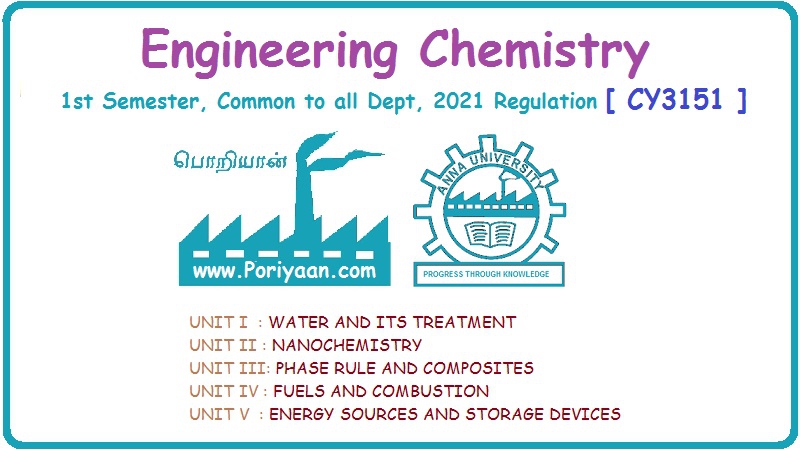Engineering Chemistry: Unit I: Water and its Treatment
Anna University Questions
Water and its Treatment | Engineering Chemistry
Engineering Chemistry : UNIT I : Water and its Treatment : Anna University Questions
ANNA UNIVERSITY
QUESTIONS
1. Define and explain the significances of the followings.
(i) Clour
(ii) Tastes and odours
(iii) pH
2. Explain the significances of
(a) TDS
(b) COD
(c) BOD
3. What is meant by sterilization of water? What are the chemicals
that are normally used for this purpose? Explain break-point chlorination.
4. Explain how sterilisation of water carried out using chlorine?
Give the mechanism.
5. Explain with a neat sketch the various steps in the treatment
of water for municipal supply.
6. What is desalination? With a neat diagram, describe the ‘reverse
osmosis method for the desalination of brackish water. (Chen A.U. Jan 2010)
7. What is desalination? Explain any one method of desalination.
(Coim A.U. Jan 2010) (AU Jan 2013)
8. What is reverse osmosis? How will you purify the sea water by
reverse osmosis? Mention its advantages. (TNV A.U. Jan 2010)
9. What is meant by reverse osmosis? Explain the purification of
water by reverse osmosis. (Chen. A.U. Jan 2009, May 2008)
10. Describe the Reverse Osmosis method for desalination of water.
(Chen A.U. June 2009)(TNV. AU. May 2009, May 2017)
11. Define the term desalination with a neat diagram, describe
desalination by reverse osmosis method. (Dec 2003; May 2003, May 01)
12. What are boiler troubles? How are they caused? Suggest steps
to minimize the boiler troubles. (A.U. Dec 97)
13. What are boiler troubles? How they are caused? How they are
minimized by colloidal conditioning, phosphate conditioning and calgon
conditioning. (A.U. May 2007)
14. Discuss the disadvantages of using hard water in boilers. (Chen
A.U. Dec 2006)(TNV. AU. Jan 2009)
15. What are scales and sludges. Describe the disadvantages of
scale and sludge formation. (A.U. June 05 A.U.TNV A.U. Jan 2010)
16. What is caustic embrittlement. How can it be prevented. (A.U.
June 05)
17. Discuss the causes and prevention of priming and foaming (A.U.
June 06)
18. What are the problems one would face when hard water is used
in boiler industries. (A.U. Dec. 05)
19. Explain the following boiler troubles suggesting the remedial
methods:
(i) Sludge and scale formation
(ii) Caustic embrittlement. (CBE. A.U. Jan 2009) (AU Jan 2013)
20. How will you protect boiler from corrosion. (A.U. Dec. 06)
21. Describe de-mineralisation process of water softening. Explain
the reactions involved. (A.U Dec-2002, May 2007, May 2008)
22. How is the exhausted resin regenerated in an ion-exchanger?
What are the merits and demerits of ion-exchange method? (A.U. Model Q.P)
23. With a neat diagram describe the ionization process of water
softening. (TNV. AU. May 2009)
24. Explain how demineralization of water is done in water
technology? (CBE. A.U. Jan 2009)
25. Explain the softening of water by deionization process. (TNV
A.U. Jan 2009)(Chen. A.U. Jan 2009)
26. Explain the demineralization of water by ion-exchange process.
How are exhausted cation and anion exchange resins regenerated? (TNV A.U. Jan
2010, A.U May 2017)
27. How is the softening of water carried out using the zeolite
process? (TCY A.U. Jan 2010)
28. Describe the principle and procedure involved in the zeolite
process for water treatment. (A.U Jan 2013)
29. What are ion exchange resins? How are they useful in removing
hardness of water. (Chen A.U. Jan 2010)
30. How is internal treatment of boiler water carried out using
phosphate and calgon. (A.U. June 06)
31. Explain the Phosphate conditioning. (A.U. Dec. 05)
32. Give an account of internal treatment of boiler water. (A.U.
Dec 2006, Jan 2013)(TNV. AU. Jan 2009)
33. Describe briefly the various methods of internal conditioning
of boiler feed water. (Chen. A.U. June 2009)
34. What is calgon? Why is calgon conditioning better than phosphate
conditioning? (TNV A.U. Jan 2010)
35. Explain the boiler troubles, “scales and caustic embrittlement
in detail. (AU June 2014, May 2017)
36. How is water softened by Ion exchange method? Explain in
detail with a neat diagram. (AU June 2014)
37. What are zeolites? How do they function in removing the
hardness of water? (AU June 2014)
38. What is meant by internal conditioning of water? (AU June 2017)
39. What are the factors which causes boiler corrosion? How can it
be minimized? (A.U Dec 2014)
40. With necessary diagram, describe the reverse osmosis method
for the desalination of brackish water. (A.U Dec 2014)
41. Write a brief note on the following:
1. Caustic embrittlement
2. Calgon conditioning (A.U Dec 2014)
42. Describe the principle and procedure involved in the zeolite
process for water treatment. (A.U Dec 2014)
43. What is reverse osmosis? How is it useful for desalination of
brackish water? Explain with a diagram. (AU
May 2015)
44. What are sludge and scale in boilers? How are they formed? Suggest
any two methods to prevent their formation. (AU May 2015)
45. What are zeolites? How are they used in softening of water?
Use a diagram for your explanation? (AU May 2015)
46. Explain the internal conditioning of water? Take two examples
for your explanation. (AU May 2015)
47. Draw a suitable diagram and describe the ion exchange process
for the softening of hard water. (AU Dec 2015)
48. Write a brief note on priming and foaming. (AU Dec 2015)
49. How can the boiler feed water be purified by calgon and
phosphate conditioning? (AU Dec 2015)
50. With neat diagram, explain the Zeolite process for water
treatment
(AU June 2016)
51. Describe the demineralization process of water softening and
write down the reaction involved in it. (AU
June 2016)
52. Explain with neat diagram, the desalination of brackish water of reverse osmosis method. (AU
June 2016)
Engineering Chemistry: Unit I: Water and its Treatment : Tag: Engineering Chemistry : Water and its Treatment | Engineering Chemistry - Anna University Questions
Related Topics
Related Subjects
Engineering Chemistry
CY3151 1st Semester | 2021 Regulation | 1st Semester Common to all Dept 2021 Regulation
